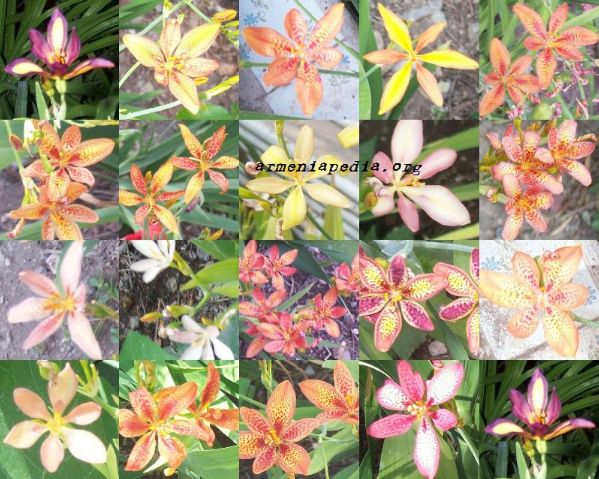Candy lily
| Pardancanda norrisii subsp. var. | Candy Lily | |||||||||||||||||||||||||||||||||||||||||||||||||||||||
|---|---|---|---|---|---|---|---|---|---|---|---|---|---|---|---|---|---|---|---|---|---|---|---|---|---|---|---|---|---|---|---|---|---|---|---|---|---|---|---|---|---|---|---|---|---|---|---|---|---|---|---|---|---|---|---|---|

|
|
| ||||||||||||||||||||||||||||||||||||||||||||||||||||||
| ||||||||||||||||||||||||||||||||||||||||||||||||||||||||
Candy lily flowers closely resemble those of Belamcanda. It is a bigeneric genus (Belamcanda chinensis x Pardanthopsis dichotoma). Flowers primarily bloom in July-August, with some sporadic continued bloom to frost. Each flower lasts only one day. Sword-shaped, iris-like leaves. Flowers are followed by seedpods which resemble blackberries and provide some interest in autumn.
Starry flowers in single colors, tiger stripes and spotted. Colors range from yellow, red, salmon , pink, or white shades. Iris-like foliage. Tolerates heat and drought well.
Often misspelled Pardancanda norisii, the plant commonly known as the Candy Lily was probably first introduced to the world by Park Seed Company.

Cultivation
Best grown in dry to medium moisture, well-drained soils in full sun to part shade. Best in full sun. Tolerates summer heat and drought. Prefers sandy, humusy soils. Appreciates a light winter mulch in USDA Zone 5.
Propagation
Pests and diseases
No serious insect or disease problems.
Varieties
'Dazzler' is a dwarf strain which features 6-petaled, saucer-shaped flowers (2" across) in a variety of colors including yellow, orange, pink, purple and red on scapes growing to 16" tall.
Gallery
-
photo 1
-
photo 2
-
photo 3
References
- Standard Cyclopedia of Horticulture, by L. H. Bailey, MacMillan Co., 1963
External links
- w:Candy lily. Some of the material on this page may be from Wikipedia, under the Creative Commons license.
- Candy lily QR Code (Size 50, 100, 200, 500)
